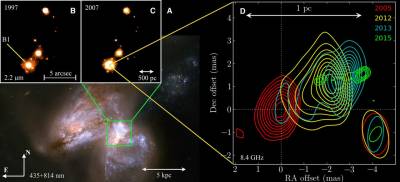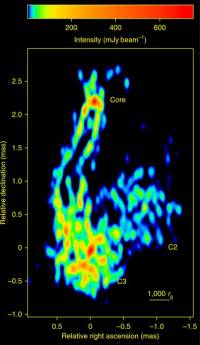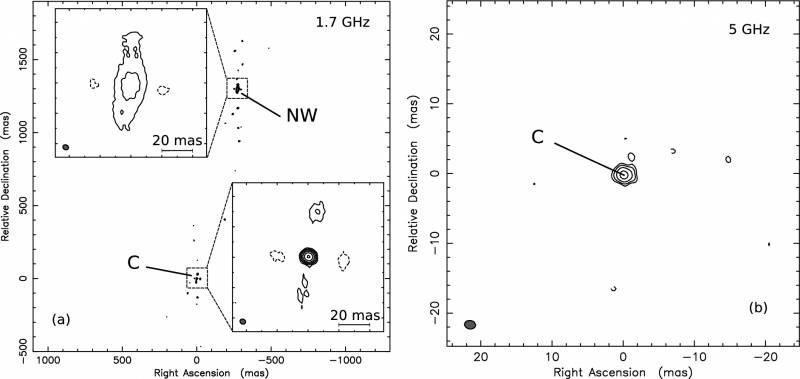Table of Contents
A selection of recent EVN Science
Introduction
The European VLBI Network (EVN) is a VLBI network of radio telescopes in Europe and beyond, operated by an international Consortium of institutes. The EVN operates an “open sky” policy and observing proposals are accepted (and peer-reviewed) from astronomers from all over the world.
The next deadline is 1st of June 2021 16:00 UTC.
VLBI continuum observations generally observe high brightness temperature radio emission from synchrotron or gyro-synchrotron processes with thermal emission perhaps detectable on short baselines. Radio spectral lines are observable in maser emission (mainly OH, H2O, CH3OH, and SiO) and in absorption against bright continuum sources (mainly in HI and OH).
VLBI observations with full-Stokes correlation allow investigation of polarization structure within your continuum or spectral-line sources. This in turn would allow detection and estimation of magnetic fields and ionised gas densities via Zeeman splitting, Faraday rotation, and Faraday depolarisation mechanisms.
VLBI has the extreme angular resolution to follow changes in source structure on timescales of hours (for stars), months (for many Galactic objects), and years (for many high-redshift systems).
Absolute and relative astrometry of compact radio structure is possible at the (sub)milliarsecond level, which for Galactic objects may allow the measurement of both parallax and proper motion to be made.
A selection of recent refereed EVN publications is presented here.
Gravitationally-lensed radio arcs observed with global VLBI
The Strong lensing at High Angular ResoluTon Program (SHARP) led by McKean (ASTRON) has obtained a deep global VLBI observaTon of the gravitaTonal lens MG J0751+2716 at 1.65 GHz (project GM070; PI: McKean). The 18.5 hours observation used 24 antennas from the EVN and the VLBA, including the large apertures (> 50 m) of the Lovell, Effelsberg, Robledo and Green Bank telescopes. Data were recorded at 512 Mbps and correlated at JIVE to produce 8 spectral windows (IFs) with 8 MHz bandwidth and 32 channels each, through both circular polarisaTons. MG J0751+2716 is one of the few quadruply imaged radio-loud gravitationally lensed quasars that show extended arcs on VLBI-scales. The global VLBI L-band deep imaging detects all of the extended arcs at high significance, showing the complex surface brightness structure of the background source in unprecedented detail (see Figure from Spingola et al (2018)). Because of the complexity of this system, the imaging was performed using multi-scale cleaning within the wsclean algorithm (Offringa et al. 2014). The total flux density of the target is 350 mJy and the off-source rms is 41 μJy/beam. Never before have such extended (200-600 mas) gravitational arcs been detected at an angular resoluTon of a few mas. The excellent uv-coverage and surface brightness sensitivity provided by the global VLBI array have been fundamental for a precise study of the structure of the extended arcs on mas-scales from MG J0751+2716.
Figure 1.Global VLBI imaging of MG J0751+2716 at 1.65 GHz (Spingola et al. (2018)). The off-source rms is 41 μJy/beam and the peak surface brightness is 2.9 mJy/beam. The restored beam is 5.5×1.8 mas, and is shown within the white box in the bottom-hand corner.
Spingola et al. (2018) analysed these observations and identified lensed emission corresponding to the same source component, providing a very large number of constraints on the mass model that also sampled a large radial and tangential extent. When performing the mass modelling of this system, they found a discrepancy between the observed and predicted positions of the lensed images, with an average position rms of the order of 3 mas, which is much larger that the measurement errors (40 μas on average). A possible explanation for the offset between the observed and model-predicted positions is the presence of some additional mass structure (e.g. Metcalf & Madau 2001). However, since the lensing galaxy lies in a small group of galaxies, it is not clear whether this extra mass is in the form of sub-haloes within the lens or along the line of sight, or from a more complex halo for the galaxy group. Furthermore, the lens mass model suggests an inner density slope for the main lensing galaxy that is steeper than isothermal. This is consistent with studies of other low-mass early-type satellite galaxies in dense environments, and is in agreement with the two-phase galaxy formation scenario (Guo & White 2008).
A dust-enshrouded tidal disruption event with a resolved radio jet in a galaxy merger
Tidal disruption events (TDEs) are transient flares produced when a star is ripped apart by the gravitational field of a supermassive black hole (SMBH). In a TDE, roughly half of the star’s mass is ejected, whereas the other half is accreted onto the SMBH, generating a bright flare that is normally detected at X-ray, ultraviolet (UV), and optical wavelengths. TDEs are also expected to produce radio transients, lasting from months to years and including the formation of a relativistic jet, if a fraction of the accretion power is channelled into a relativistic outflow. An international team of astronomers have, for the first time, directly imaged the formation and expansion of a fast-moving jet of material ejected when the powerful gravity of the SMBH in the nucleus of Arp 299-B (D=45 Mpc) ripped apart a star that wandered too close to the cosmic monster in Arp 299-B. It is one of the two merging galaxies (Arp 299-A and Arp 299-B) forming the Arp 299 system, which hosts prolific supernova factories in its nuclear regions. The team tracked the event with radio and infrared telescopes, including the EVN, for over a decade. The patient, continued observations with the EVN and other radio telescopes around the world, eventually showed the source of radio emission expanding in one direction, just as expected for a jet (Fig. 2). The measured expansion indicated that the material in the jet moved at an average of about one-fourth the speed of light. The crucial piece of information solving the puzzle of this event was provided by VLBI observations, as the inferred angle of the jet to the line-of-sight was in clear disagreement with expectations from a “normal” AGN jet, while in the case of a TDE this angle can have any value.
Figure: The tidal disruption event Arp 299-B AT1 and its expanding radio jet. (A) A color-composite optical image from the HST, with high-resolution, near-IR 2.2 micron images [insets (B) and (C)] showing the brightening of the B1 nucleus. (D) Radio evolution of Arp 299-B AT1 as imaged with VLBI at 8.4 GHz [7×7 mas region with the 8.4-GHz peak position in 2005, RA= 11h28m30.9875529s, dec= 58°33ʹ40ʹʹ.783601 (J2000.0), indicated by the dotted lines]. The VLBI images are aligned with an astrometric precision better than 50 mas. The initially unresolved radio source develops into a resolved jet structure a few years a_er the explosion, with the centre of the radio emission moving westward with time at an average intrinsic speed of 0.22 >mes the speed of light. The radio beam size for each epoch is indicated in the lower-right corner.
The gravitational field of the SMBH in Arp 299-B, with a mass 20 million Tmes that of the Sun, shredded a star with a mass more than twice that of the Sun. This resulted in a TDE that was not seen in the optical or X-rays because of the very dense medium surrounding the SMBH, but was detected in the near-infrared and radio. The so| X-ray photons produced by the event were efficiently reprocessed into UV and optical photons by the dense gas, and further to infrared wavelengths by dust in the nuclear environment. Efficient reprocessing of the energy might thus resolve the outstanding problem of observed luminosities of optically detected TDEs being generally lower than predicted. The case of Arp 299-B AT1 suggests that recently formed massive stars are being accreted onto the SMBH in such environments, resulting in TDEs injecting large amounts of energy into their surroundings. However, events similar to Arp 299-B AT1 would have remained hidden within dusty and dense environments, and would thus not be detectable by optical, UV or so| X-ray observations. Such TDEs from relatively massive, newly formed stars might provide a large radiative feedback, especially at higher redshifts where galaxy mergers and luminous infrared galaxies like Arp 299 are more common.
Published in: Makla S., Perez-Torres M., et al.: A dust enshrouded tidal disruption event with a resolved radio jet in a galaxy merger. Science, 2018
Space-VLBI observations resolve the edge-brightened jet in 3C 84 (NGC1275) at 30 microarcseconds from the core
An international team of researchers from eight different countries has imaged with unprecedented accuracy the newly forming jets of plasma from the core of NGC1275, the central galaxy of the Perseus cluster, identified with radio source 3C 84. Radio images made with an array including the RadioAstron Space Radio Telescope (SRT) and a global array of ground radio telescopes resolve the jet structure ten times closer to the central engine than what has been possible in previous ground- based observations. These space-VLBI observations were obtained within the RadioAstron Nearby AGN Key Science Project coordinated by Tuomas Savolainen. 3C 84 was observed on September 21-22, 2013. In addition to SRT, more than two dozen ground radio telescopes, including the EVN, the KVN, Kalyazin and the NRAO VLBA, GBT and the phased JVLA participated in the experiment. First results are now published in Giovannini et al. (2018).
Figure: Radio image of the central parsec in 3C 84 obtained with the space-VLBI array. The half- power-beam-width (HPBW) is 0.10 x 0.05 mas at PA 0o. The noise level is 1.4 mJy/beam and the peak intensity is 0.75 Jy/beam. The radio core and emission features C2 and C3 are indicated in the image.
The 22 GHz space-VLBI image shows that the edge-brightened jet in 3C 84 is surprisingly wide, with a transverse radius greater than 250 gravitational radii at a de-projected distance of 350 gravitational radii from the core. If the bright outer jet layer is launched by the black hole ergosphere, it has to rapidly expand laterally closer to the central engine. If this is not the case, then this jet sheath is likely launched from the accretion disk.
Another major result discussed in the paper is that the previously known, almost cylindrical jet collimation profile on the scales larger than a few thousand gravitational radii extends down to a scale of a few hundred gravitational radii. It indicates a flat density profile of the external confining medium. This result is in contrast with the M87 jet collimation profile. One obvious difference between M87 and 3C 84 jets is the young age of the latter. The dynamical age of the C3 feature (the head of the restarted jet in 3C 84) at the time of the space VLBI observation is only about 10 years. The dynamical age of the jet is less than what is likely needed for the relaxation of the system, and we may not be seeing the final structure of the jet.
The Repeating Fast Radio Burst FRB 121102 as seen on milliarcsecond angular scales
Chatterjee et al. (2017) has been able to locate (with a 100 mas precision) the repeating FRB 121102. This has led to its unambiguous association with persistent radio and optical counterparts, and to the identification of its host galaxy. However, an even more precise localization is needed in order to probe the direct physical relationship between the millisecond bursts themselves and the associated persistent emission.
Marcote et al. (2017) report EVN observations, which simultaneously detect both the bursts and the persistent radio emission at milliarcsecond angular scales and show that they are co-located to within a projected linear separation of 40 pc (12 mas angular separation, at 95 % confidence). They detect consistent angular broadening of the bursts and persistent radio source (∼2–4 mas at 1.7 GHz), which are both similar to the expected Milky Way scattering contribution. They argue that a burst source associated with a low-luminosity active galactic nucleus or a young neutron star energizing a supernova remnant are the two scenarios for FRB121102 that best match the observed data.
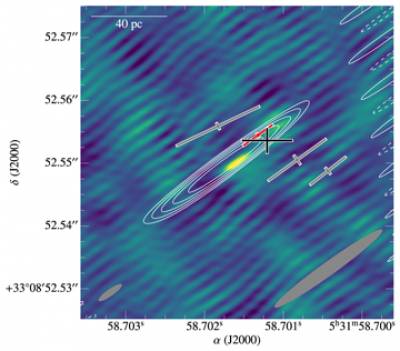 Figure 1. EVN image of the persistent source at 1.7 GHz (white contours) together with the localization of the strongest burst (red cross), the other three observed bursts (gray crosses), and the position obtained after averaging all four bursts detected on 2016 September 20 (black cross).
Figure 1. EVN image of the persistent source at 1.7 GHz (white contours) together with the localization of the strongest burst (red cross), the other three observed bursts (gray crosses), and the position obtained after averaging all four bursts detected on 2016 September 20 (black cross).
Physical properties and astrometry of radio-emitting brown dwarf TVLM513-46546 revisited
Gawronski et al. 2017 present multi-epoch astrometric observations of the M9 ultra-cool dwarf TVLM513-46546 that is placed at the brown dwarf boundary. The new observations have been performed with the EVN at 6 cm. The target has been detected at 7 epochs spanning three years, with measured quiescent emission flux in the range 180-300 muJy. Combined with Very Long Baseline Array (VLBA) earlier data, their detections make it possible to refine the absolute parallax pi=93.27(+0.18,-0.17) mas. The data rule out TVLM513-46546 companions more massive than Jupiter in orbits with periods longer than ~1 yr.
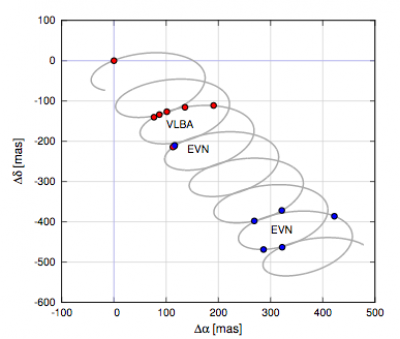 Figure 2. Sky-projected, 5-parameter astrocentric model of TVLM 513 positions (grey curve) over-plotted with the VLBA (red filled circles) and with all new EVN detections (blue filled circles), relative to the first observation in (Forbrich et al. 2013).
Figure 2. Sky-projected, 5-parameter astrocentric model of TVLM 513 positions (grey curve) over-plotted with the VLBA (red filled circles) and with all new EVN detections (blue filled circles), relative to the first observation in (Forbrich et al. 2013).
Extended CH3OH maser flare excited by a bursting massive YSO
Moscadelli et al. (2017) followed an outburst in the 6.7 GHz methanol maser line (and in the IR) in the high-mass young stellar object S255. The goal was to study the change in the properties of the between the pre- and outburst phases. Both the maser flare and the extraordinarily large extent of the maser structure can be a natural consequence of the burst in the accretion luminosity of the high-mass YSO. Their results strongly support models that predict IR radiative pumping for the 6.7 GHz CH3 OH masers.
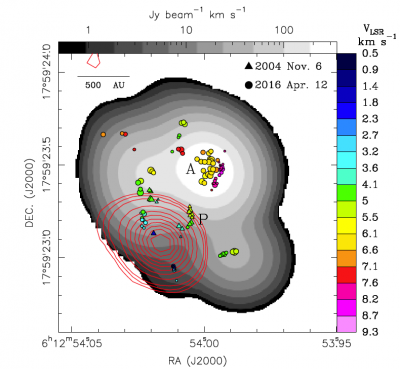 Figure 3. Distribution of the 6.7 GHz CH3OH masers toward NIRS 3. Circles and triangles represent maser spots before and after the outburst, respectively. Relative maser positions between the two epochs are accurate within a few mas. For more details, see Moscadelli et al. (2017).
Figure 3. Distribution of the 6.7 GHz CH3OH masers toward NIRS 3. Circles and triangles represent maser spots before and after the outburst, respectively. Relative maser positions between the two epochs are accurate within a few mas. For more details, see Moscadelli et al. (2017).
VLBI observations of four radio quasars at z > 4: blazars or not?
Cao et al. (2017) report the observations of four blazar candidates at redshift z > 4 with the European VLBI Network (EVN) at 1.7 and 5 GHz. These objects were previously classified as blazar candidates based on X-ray observations. One of them, J2134−0419 is firmly confirmed as a blazar with our VLBI observations, due to its relativistically beamed radio emission. Another target, J0839+5112 shows a compact radio structure typical of quasars. There is evidence for flux density variability and its radio ‘core’ has a flat spectrum. However, the EVN data suggest that its emission is not Doppler-boosted. The remaining two blazar candidates (J1420+1205 (see Fig. 4) and J2220+0025) show radio properties totally unexpected from radio AGN with small-inclination jet. Their emission extends to arcsec scales and the Doppler factors of the central components are well below 1. Their structures resemble that of double-lobed radio AGN with large inclination to the line of sight. Their work underlines the importance of high-resolution VLBI imaging in confirming the blazar nature of high-redshift radio sources.
Figure 4. Naturally weighted VLBI images of J1420+1205 at 1.7 and 5 GHz. At 5 GHz, only the south-eastern component was detected, which appears brighter and more compact in the 1.7-GHz image. The first contours are drawn at ±5σ image noise level. The positive contours increase by a factor of 2. The synthesized beam (FWHM) is shown at the lower-left corner of each image.
A multiwavelength study of GRB 151027A: the 999th Swift GRB
Nappo et al. (2017) study the X-ray, optical and radio emission of the bright Gamma Ray Burst GRB151027A. The radio late time curve proved essential to constrain the burst environment and jet energy. EVN observations, performed 22 and 138 days after the GRB, coupled with VLBA data taken in between (89 days) and an early-time (3 days) SRT upper limit, provide compelling evidence of a jet decelerated by a stratified density environment. This is what is expected if the progenitor were a massive W-R which underwent intense mass loss prior to its explosion. EVN observations (138 days after the burst) modelled together with early time X-ray and Optical data, lead to estimate a jet opening angle of 6.3 degrees and a jet radiative energy of 2.4×10^50 erg.
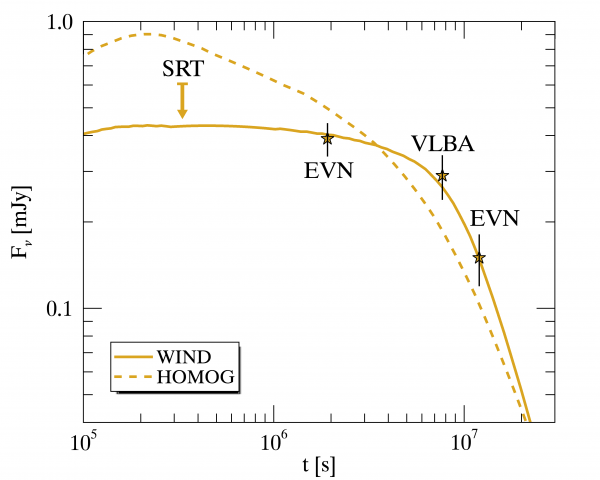 Figure 5.
Radio observations (star symbols) performed with the EVN (at 22 and 138 days) and with the VLBA at 89 days. The SRT upper limit is also shown. The model curves show the case of a jet expanding in a constant density interstellar medium (solid line) and in a stratified density profile (where the density scales as the distance from the source as r^-2). These curves are obtained reproducing also the X-ray and optical data, not shown here for clarity.
Figure 5.
Radio observations (star symbols) performed with the EVN (at 22 and 138 days) and with the VLBA at 89 days. The SRT upper limit is also shown. The model curves show the case of a jet expanding in a constant density interstellar medium (solid line) and in a stratified density profile (where the density scales as the distance from the source as r^-2). These curves are obtained reproducing also the X-ray and optical data, not shown here for clarity.
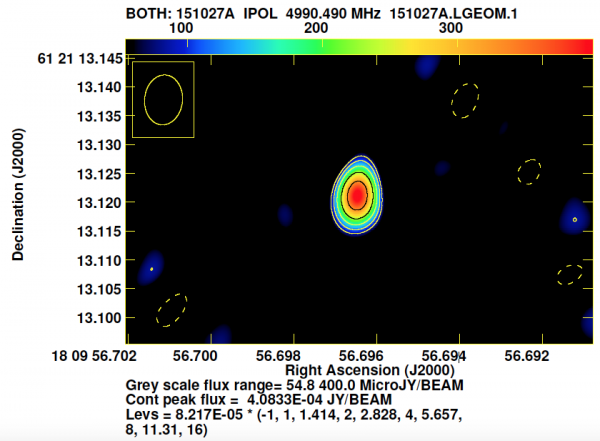 Figure 6.
The 5 GHz EVN image of GRB 151027A taken on 2015 November 18.
Figure 6.
The 5 GHz EVN image of GRB 151027A taken on 2015 November 18.
No AGN evidence in NGC 1614 from deep radio VLBI observations
Herrero-Illana et al. (2017) present deep dual-band 5.0- and 8.4 GHz EVN observations of NGC 1614, a local luminous infrared galaxy with a powerful circumnuclear starburst ring, and whose nuclear engine origin is still controversial. The aim was to detect and characterize any compact radio structures both in the nuclear region and in the circumnuclear ring. They did not find any compact source in the central 200 pc region. However, they do detect a compact source in the circumnuclear ring located about 0.6 arcsec (190 pc) to the north of the nucleus. Its luminosity and spectral shape are indicative of a SN origin, possibly a Type IIn or Ic. Their result favours the pure starburst scenario, even for the nucleus of NGC 1614.
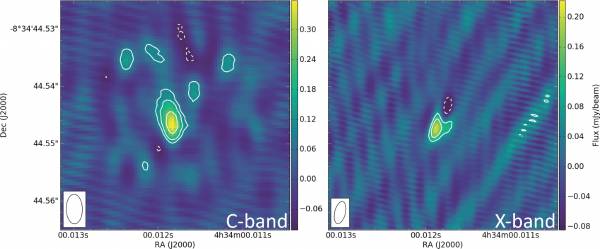 Figure 7.
EVN maps of the detected compact source at the C band (5.0 GHz; left-hand panel) and the X band (8.4 GHz; right-hand panel).
Figure 7.
EVN maps of the detected compact source at the C band (5.0 GHz; left-hand panel) and the X band (8.4 GHz; right-hand panel).



